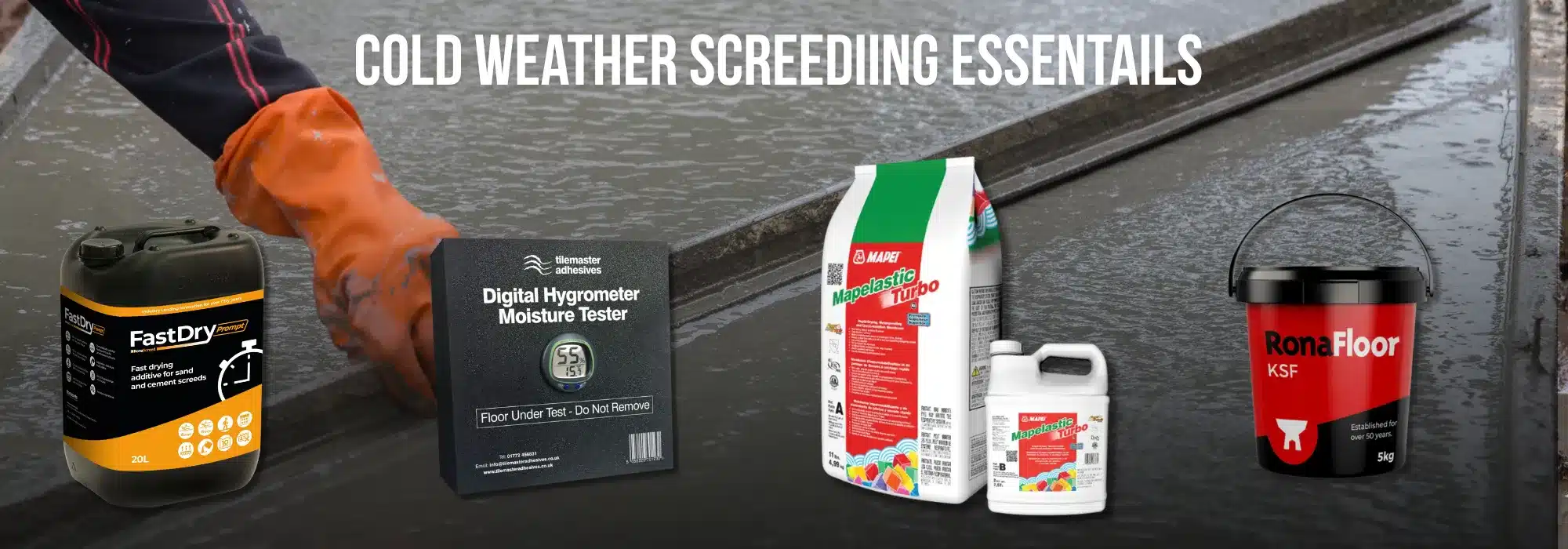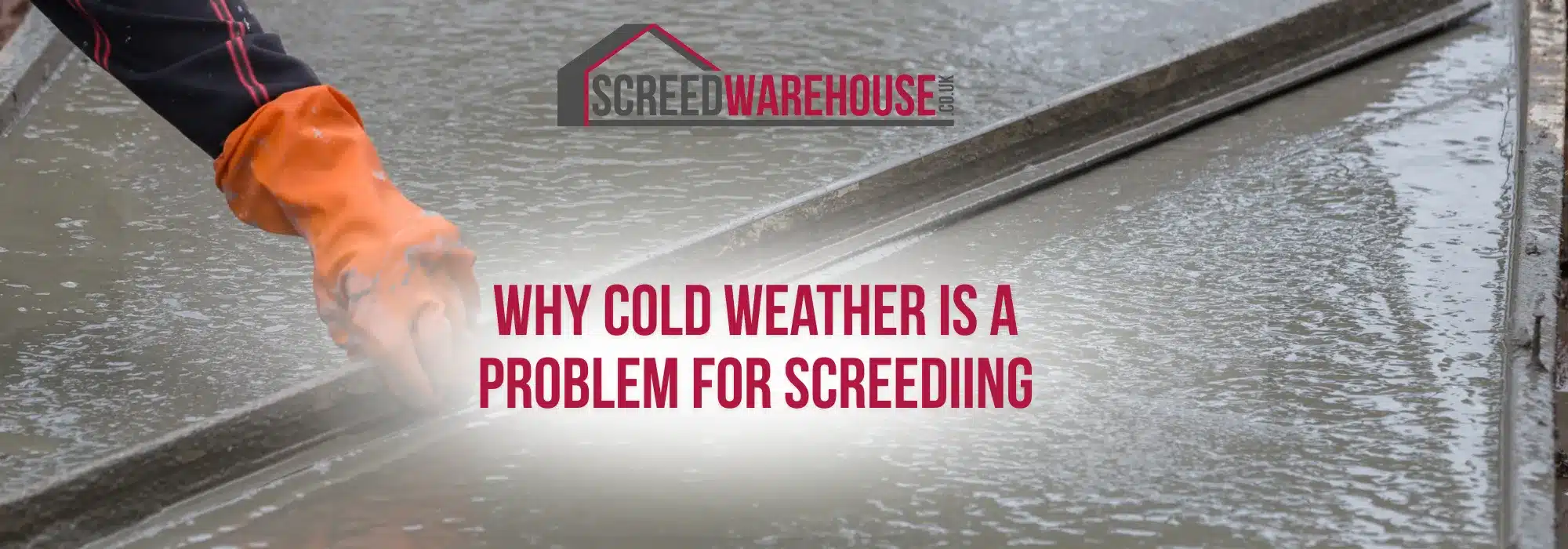Why Cold Weather Is a Problem for Screeding
Slower Hydration & Strength Gain
Screed (often cementitious or cementitious + additives) hardens through hydration—cement reacting with water. Low temperatures slow this chemical reaction significantly, delaying strength gain and increasing vulnerability.
If the water in the screed freezes before hydration has progressed, expansion can cause micro-fracturing or outright failure.
Reduced Ability of Cold Air to Evaporate Moisture
One of the reasons drying takes longer is that cold air holds less moisture. Evaporation—needed to remove excess water from the screed—becomes less efficient as the ambient temperature drops. Screed Giant notes this directly: cold air holds less water, extending drying times. risk of Thermal Shock & Cracking
Try to “force-dry” too aggressively—i.e. blasting high heat— and you risk differential drying (surface dries too fast relative to underlying layers), which may lead to shrinkage cracks. Screed Giant explicitly warns against cranking up the heat, as that can lead to cracking.
In addition, if the substrate (the base under the screed) or the surrounding surfaces are cold, the screed will lose heat and may not cure evenly. The interface between screed and substrate is a common weak point.
Extended Drying Times
During winter, the time required to reach acceptable moisture levels can easily double (or worse). Some sources warn that what might take weeks in warmer months may take many more in chilly, humid conditions.
Because of all these factors, working in cold weather demands careful planning, control, and patience.
Temperature Guidelines & Thresholds
To avoid damaging the screed, industry guidelines generally recommend:
Parameter | Recommended Bounds / Notes |
| Air temperature | Do not place screed when the ambient air is below about 3 °C (on a falling thermometer). Some sources allow work to resume when the temperature is rising past 2-3 °C. |
| Screed / mix temperature | The screed as delivered/mixed should not be too cold. Some manufacturers require ≥ 5 °C. |
| Substrate (base) temperature | The base or ground supporting the screed must not be frozen or cold; it should be warmed so it doesn’t act as a cold sink. |
| Protection period | After placement, maintain temperatures in the safe range (≥ 5 °C where required) for at least the first 48–72 hours (some sources extend this to 4–5 days). |
Cemfloor’s guidelines, for example, state that both air and base slab temperatures should remain between 5 °C and 30 °C during placement and for at least 72 h afterwards. Cemfloor The Gyvlon cold weather guidelines likewise specify that work should stop when the air temperature is 3 °C and falling, and resume only when temperatures recover.
If these thresholds cannot be maintained, many would advise postponing screed placement until conditions improve (if the schedule allows).
Preparatory Measures & Best Practices
Before you mix or pour any screed under cold conditions, take steps to reduce risk. Below is a list of best practices drawn from multiple sources:
Warm and store materials
Keep cement, aggregates, and mixing water in a dry, warm environment above freezing.
Prewarm mixing water (not too hot) to raise the initial mix temperature.
Avoid mixing with frozen aggregates or using materials that are cold or damp.
Warm the substrate/base slab
Use temporary heating, insulated blankets, or heated enclosures to raise the temperature of the slab before laying screed.
If the substrate is cold, it will draw heat from the screed, retarding curing and increasing the risk.
Provide protection and enclosure.
Work inside enclosed or weather-tight buildings where possible, to shield from wind, rain, snow, and drafts.
Use temporary sheeting, tarpaulins, thermal blankets, or polythene covers over freshly laid screed (supported slightly above to avoid pressing on the surface).
Overlap covers and secure edges to prevent wind from lifting or allowing cold air under the sheeting.
Ensure adequate ventilation & air movement (without direct drafts)
Moisture must escape; otherwise drying is hampered. Provide controlled ventilation to exchange humid air for drier air while maintaining temperature.
Use fans or air movers to circulate air, but avoid directing airflow directly across the screed surface (can cause uneven drying or surface cracks).
Use additives or special screed formulations.
Use accelerators or fast-drying additives to speed early strength gain and reduce moisture content. For example, RonaScreed FastDry Prompt claims 50 mm screeds may accept coverings after 4 days under ideal conditions.
Use low water/cement ratio mixes, plasticisers, or early strength binders to reduce free water in the mix.
Choose screed products or blends specifically designed to perform better under cold / winter conditions (check manufacturer datasheets).
Timing and staging
It is preferable to pour during the warmer parts of the day when temperatures peak.
Avoid pouring screed when the temperature is falling or just before a cold snap.
Delay non-essential floor finishes or loads until the screed has adequately cured and dried.
Managing & Accelerating Drying (Once Screed Is Laid)
Even after taking all precautions, drying will likely be slower than in warmer months. But you can manage and optimise the process:
Controlled “Force Drying”
Force drying involves combining low-level heat, dehumidification, and air movement in a controlled way to accelerate drying without damaging the screed.
Use electric or indirect heaters to gently warm the air (e.g. 18–25 °C, or as recommended for the specific screed product).
Use dehumidifiers to remove moisture from the air. This helps keep the humidity low so more moisture migrates out of the screed.
Run air movement (fans) to distribute the warmed, dehumidified air evenly.
Buxton Flow Screeds notes that while heaters speed evaporation, if you don’t remove moisture from the air, that moisture can just linger and slow further drying. Thus, heaters + dehumidifiers often work best together.
Force Drying Ltd offers specialist equipment (electric boilers, etc.) to maintain ambient heat and manage humidity automatically.
You must proceed cautiously — raise temperature gradually, avoid thermal shock, and monitor moisture levels throughout.
Phased Heating of Underfloor Heating Screeds
If your screed involves underfloor heating (UFH), you may use the heating circuits in a controlled ramp-up fashion:
Wait the recommended “waiting period” (often several days) before switching on the heating (i.e. allow initial set).
Then gradually raise temperature (say +5 °C increments) over time to avoid stressing the screed.
Eventually run the system at a moderate temperature (e.g. 20–25 °C) to help desorb residual moisture.
However, always follow the screed / UFH system manufacturer’s guidance for allowable temperature ramps and limits.
Monitoring & Testing
You must monitor moisture throughout, not just assume drying is complete.
Use hygrometers, relative humidity probes, or CM (calcium carbide) or other moisture tests to check residual moisture in the screed prior to laying final flooring.
Be wary of surface dryness alone — deeper moisture may still be present.
Use manufacturer guidelines for acceptable moisture content (often expressed as RH % or moisture content by weight).
If moisture is still too high, delay floor coverings or use further drying.
Patience & Conservative Scheduling
Even with assisted drying, progress will often be slower than expected. Build buffer time into your schedule, especially for winter projects. Many contractors advise extending drying times, particularly for thicker screed layers.
Common Problems & How They Arise in Cold Conditions
Even with precautions, cold-weather screeding may still suffer from common issues. Understanding the causes helps in prevention and remediation.
Cracking / shrinkage: Rapid or uneven drying (e.g. top surface dries faster than deeper zones) can cause tensile stresses and cracking. This is aggravated by forcing heat or drafts.
Delamination (lifting or separation): If the screed fails to bond to the substrate due to cold, moisture, or inadequate adhesion, layers may separate.
Dusty, weak surface: If hydration is interrupted (e.g. by freezing) or the screed remains overly wet, the surface may degrade, becoming dusty or weak.
Curling or warping: Nonuniform shrinkage across the screed area (edges vs centre) may cause warping or lifting at edges.
Delayed floor finish defects: If the final flooring is applied before moisture conditions are safe, it may delaminate, blister, or degrade over time.
Many of these problems stem from trying to speed things up too aggressively or failing to maintain a stable, controlled environment.

Practical Checklist for Screeding in Cold Weather
Below is a summary checklist to guide operations-
Pre-work checks
-
-
Is ambient air ≥ 3 °C (rising) or acceptable per manufacturer?
-
Is the substrate dry, thawed, and ≥ 5 °C?
-
Are all materials (cement, aggregates, water) stored in non-freezing conditions?
-
-
Mixing & delivery
-
-
Pre-warm mixing water (moderately).
-
Maintain mix temperature per product guidelines.
-
Avoid cold or damp aggregates or components.
-
-
Pouring & finishing
-
-
Do not pour on frozen or wet/icy surfaces.
-
Avoid exposure to drafts, wind, or sudden cooling.
-
Use correct finishing tools and avoid overworking the surface.
-
-
Protection & enclosure
-
-
-
Cover with thermal blankets, polythene, or sheeting.
-
Seal the space to reduce external infiltration of cold air.
-
-
Support covers off the surface so air can circulate gently.
-
-
Maintain a controlled environment
-
-
Introduce mild heat if needed (gradually).
-
Use dehumidifiers to lower air moisture.
-
Circulate air gently without direct drafts.
-
Monitor temperature and humidity continuously.
-
-
Curing & waiting period
-
-
Keep the environment within safe bounds for at least 48–72 hours (or as the screed spec demands).
-
Do not allow freezing or sharp temperature drops.
-
Use staged heating (for UFH) only per manufacturer guidance.
-
-
Drying & moisture testing
-
-
After initial set, begin controlled drying.
-
Monitor moisture at surface and deeper zones.
-
Only install final flooring when moisture is within acceptable limits.
-
-
Allow extra time & contingency
-
-
Expect delays: build buffer days/weeks in your schedule.
-
Be prepared with supplemental drying equipment if needed.
-
Don’t rush to install finishes prematurely.
-
Case Example: Using Additive-Enhanced Screed in Cold Conditions
Let’s consider a hypothetical example: a 50 mm screed using RonaScreed FastDry Prompt in a mildly cold environment (~8 °C ambient, rising). This additive claims that under nominal conditions (20 °C, 65 % RH), it allows 50 mm screeds to accept moisture-sensitive coverings in ~4 days. In colder conditions, you might:-
- Pre-warm the water to ~20 °C
- Ensure the ambient is kept above ~8–10 °C using gentle heating
- Use dehumidification and air circulation
- Plan for extra days (e.g. 6+ days) before testing moisture
- Gradually ramp up UFH if present
Conclusions
Screeding in cold weather is risky, but entirely feasible-if you plan carefully and treat temperature, moisture, and time as critical parameters. The article from Screed Giant is a helpful starting point: it highlights that cold air holds less moisture, the dangers of overheating, and some basic minimum temperature thresholds.-
- To succeed in practice, you need to combine:
- Pre-heating and warm material handling
- Enclosure and protection
- Controlled, gradual heating and ventilation
- Use of suitable additives or products
- Careful moisture monitoring
- Patience (slower drying, buffer time)


